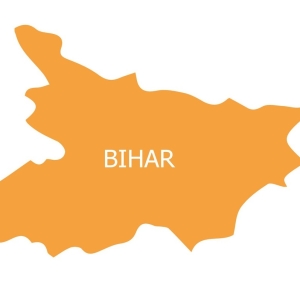
 Pachu Menon
Pachu Menon

Bihar has always fascinated me for several reasons. India's ancient history is replete with glorious accounts of the region and its magnificent past.
Bihar is derived from the Sanskrit and Pali word 'Vihara', meaning abode. It was known as Magadha in ancient times as a centre of power, learning and culture. The Maurya empire and one of the world's greatest pacifist religions, Buddhism, arose from Magadha.
But Bihar has metamorphosed into an arid expanse of dust and dirt, which hardly does justice to the celebrated narrations of a distinguished region.
The capital city of Patna, for instance! Amongst the several names the city of Patna has had in the past, at least four names relate to flowers. - Kusumpur, Pushppur, Patligram and Patliputra. Besides, several modern localities in the city, like Phulwarisharif, Gulzarbagh, Gardanibagh, Sabzibagh, and Kankarbagh, also relate to 'garden'.
Therefore, it needs no special inferring skills to understand that the city once was home to many trees and flowers. However, in the same breath, old-timers bemoan that due to its unplanned growth in recent years, Patna is fast losing its floral wealth. Even 'Patli' trees, after the city had derived its ancient name 'Patliputra', are on the verge of extinction. (B K Mishra, Patna Times)
But is it a tale of a city alone! The whole of Bihar is a story of wanton destruction brought about by development hazards. While very little of the tarred surfaces remain in the name of roads in the city and rural areas, there is little to be written about the highways in the state as they defy perceptions of an effective model of growth and development.
With recurrent mechanized excavations scarring the existing thoroughfares, a journey over them is akin to a voyage across the cratered moon.
It is, however, not only the pot-holed and dug-up roads which are a cause of concern for a visitor to the state. The maniacal and suicidal tendencies exhibited by the drivers scare the living daylights out of one. Nothing absolutely restricts pedestrians, cyclists, two-wheelers, motorists and heavy vehicles from zigzagging across the asphalted surfaces at will as they try to manoeuvre themselves along the thoroughfares. In the process, the whole exercise turns into a 'drill of extrication'.
A scene at a railway level crossing near Patna in Bihar really shocked me to my wits. A train was to cross the point, and the gateman was making frantic efforts to clear the tracks of all pedestrian and vehicular movement. But people wouldn't relent, and the gateman could not lower the bars and clear the obstruction at the level-crossing. The gateman was pleading and imploring the public to stay clear of the intersection but to no avail. There was no let-up in vehicular movement even as the blaring horns of the approaching train grew more intense. Somehow, the gateman secured the bars, allowing the speeding train to pass through. A person running across the tracks with his cycle heaved on his shoulders provided some comic relief. The bedlam at level crossings is a nightmare for gatekeepers. Not only vehicular movement, but they also have to contend with stray cattle squatting in the middle of the tracks.
I was aghast to note that vehicles on the road do not give way to ambulances in Bihar. Despite a law that mandates free passage to ambulances, obstinate commuters hardly heed the stipulated motor vehicle acts. For that matter, even the law enforcers are conspicuous by their reticence to adhere to traffic rules in Bihar. Moreover, the absence of traffic police personnel at busy junctions to ensure a smooth traffic flow is a glaring anomaly beyond one's comprehension. Traffic snarls last for several minutes to hours here. But one needs to admire the 'patience' of the locals who, although they try to do everything possible and impossible to disentangle themselves from the traffic mess, will adjust to the situation and flow with the tide, so to speak.
After watching their crazy driving 'etiquettes', I returned with a conviction that driving in the mad-melee of the North Indian states is an experience in itself. Consumed by the penchant for honking and overtaking from impossible angles, driving in Bihar is a test of nerves for those caught in the traffic. It is all the more so with two-wheelers and battery-operated rickshaws, which appear to follow their own rules, unmindful of the ruckus they cause.
As a pedestrian, one needs to be extra careful about the red stains that 'decorate' the walls and streets of the cities and villages in the North Indian states. The 'Paan-demic' problem that has assailed the North Indian states needs no special mention. In 2019, there were reports that Varanasi, as the Lok Sabha pocket borough of no less than the prime Minister of the country, who launched the Clean India Mission in 2014 to promote sanitation, has not made a difference to spitters of paan juice.
And now, with the Kashi Vishwanath Corridor project done and Varanasi holding its breath for more extensive changes, it is unfortunate that the transformation has not changed the people's attitude in 'Benares' in this regard.
Be it the 'Ghats' (the steps that lead to the banks of the Ganga), road dividers, streets or walls, red splotches left by paan eaters can be found all over the city. It is as if 'paan has entwined the culture and conventions of the people'. Talking through mouths full of chewed paan and the spittle waiting to be spewed out is an art that cannot be easily mastered! Another aspect of the development in these states, which seems strange, is how urban areas have come in for special treatment. In contrast, the shabby state of villages is a mute testimony of the total neglect of the rural regions. The scene is much the same in Bihar!
For me, however, the state of Bihar is an epitome of dirt and uncleanliness. A distinct feeling that it is the local populace that is, to an extent, responsible for this plight cannot be overlooked either. Some attribute it to the growing urban population without adequate infrastructure, high illiteracy and poverty, and high immigration. I contend that Bihar needs to come out of its past and strive to live in its present with a clear vision for the future.
Let us now look at a study in contrast! A peaceful and divine place with a dirty environment is how one could describe the Hindu shrine Vishnupad Temple in Gaya, where people throng from all over the country to pay obeisance to Lord Vishnu. For a devout Hindu coming to the temple, besides the corrupt and greedy priests, it is the filth and garbage strewn around that pains him the most. 'Bodh Gaya', the seat of Buddha's enlightenment, on the other hand, exudes an aura of divinity and sereneness. Well maintained and clean, with its lush green grass and tree cover, it could mesmerize any visitor. And only a distance of ten kilometres separates the two places!
There is no refuting the fact that politics has torn the state asunder. The state's long legacy of caste-based discrimination and violence has hindered its social and economic progress. That the politics of Bihar are dominated by regional political parties is self-evident, given that local issues have prevailed over national ones. Caste, class, and community are significant factors that have played dominant roles in Bihar's politics.
The flip-flop politics that has dominated Bihar recently has not helped matters either! Time and again, the political convulsions in Bihar have had other broader implications.
While the prices of commodities and living standards are far from unmanageable, there has been no decrease in the large-scale migration of Biharis to the more affluent states in search of better employment avenues. Rather than pander to the whims and fancies of the self-centred 'netas' as they have been doing so far, it would do a lot of good for the people of Bihar if they were to overcome the social barriers created in the name of caste and community. Regaining its lost glory should be the state's chief priority.